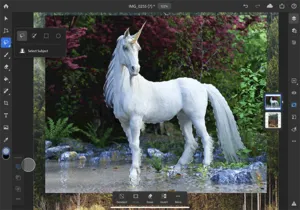The art of photo editing is a journey marked by remarkable evolution, fueled by constant technological innovation. In this dynamic scenario, Photoshop has emerged as a transformative force, empowering visual artists to transcend the boundaries of creativity. Since its inception, Photoshop has established itself as the predominant choice of professional photographers, graphic designers and enthusiasts, winning hearts and minds with its unparalleled range of features.
Adverts
In the early days of digital editing, options were limited, and each adjustment required advanced technical skills. With the advent of Photoshop, photo editing is no longer a chore, becoming accessible to a wider range of creators. Photoshop's intuitive interface has democratized image manipulation, allowing aspiring artists to express their visions more effectively.
Photoshop's popularity is a direct reflection of its ability to adapt to the ever-changing needs of visual professionals. Over the years, new features have been incorporated, expanding creative possibilities. From basic exposure adjustments to advanced layer manipulation techniques, Photoshop has evolved to meet the growing demands of a diverse community of photo editors.
Exploring the Photoshop Interface
When starting a photo editing journey, the Photoshop interface stands out as an intuitive and feature-rich universe. Efficient organization of tools allows users to easily navigate between layers, color adjustments, and filters. The palette of brushes, masks and effects offers an endless range of creative possibilities.
The strategic arrangement of these resources not only facilitates access, but also promotes a fluidity that is crucial to the efficiency of the creative process. The toolbar, with visually intuitive icons, guides editors through options ranging from precise selections to applying intricate textures. The ease of switching between different viewing modes and zoom tools further expands the ability to work in minute details.
The brush palette, in particular, deserves to be highlighted for its diversity. From standard brushes for subtle corrections to custom brushes that add unique textures, Photoshop empowers users to shape their images according to their specific vision. The masks, in turn, act as guardians, allowing elements to overlap harmoniously or stand out dramatically.
Revealing Hidden Details with Precise Adjustments
The magic of Photoshop reveals itself in the precise adjustments that allow editors to enhance previously imperceptible details. With tools like “Dodge” and “Burn,” you can brighten dark areas and add depth to key elements. “Dodge” highlights specific areas, brightening them in a controlled manner, while “Burn” does the opposite, adding shadows and depth. This fine-tuning ability is essential for highlighting nuances that would otherwise escape attention in an unedited image.
When applying “Dodge” to a face, for example, it is possible to delicately enhance the contours, highlighting subtleties such as facial expressions and light wrinkles. Likewise, “Burn” can be used to add soft shadows to certain areas, giving the image a three-dimensional feel. These tools become valuable allies for photographers, allowing them to not only correct imperfections but also enhance visual storytelling, adding emotional and aesthetic depth to photographs.
Transforming Colors and Shades
Photoshop's color palette is a playground for those looking to create unique and emotional atmospheres in their photographs. Through adjustments to saturation, color balance and gradients, it is possible to completely transform the vibrancy of an image. From vintage tones to vibrant, modern palettes, Photoshop offers the flexibility to express each editor's unique vision.
This breadth of choices not only expands the creative reach, but also allows for precise adaptation to the needs of the project. Whether enhancing the luminosity of a warm-toned sunset or diving into a cool, minimalist aesthetic, Photoshop's color palette is an essential resource. The fine adjustments provided by the software ensure that each color is enhanced according to the editor's preferences, increasing the aesthetic quality of the final image.
Furthermore, the ability to create smooth gradients and harmonious color transitions is a feature that sets Photoshop apart as an unparalleled tool. This not only enriches the visual appearance, but also highlights specific elements, directing the viewer's gaze in a strategic way. So Photoshop's color palette isn't just a set of options; it is a blank canvas ready to be painted with the editor's emotion and intent.
Refining Compositions with Cropping Tools
Composition is a vital part of visual storytelling, and Photoshop offers cropping tools that transcend conventional limitations. The “Content-Aware Fill” functionality allows you to remove unwanted elements without leaving a trace, while the transformation options allow you to adjust proportions and perspectives. These tools ensure that the photographer's vision is flawlessly translated into the final image.
“Content-Aware Fill” is a true revolution in removing unwanted elements. When you select an area to erase, Photoshop's intelligent algorithm automatically fills the space based on the surrounding content, ensuring a smooth transition that blends seamlessly with the rest of the image. This not only saves time, but also preserves the visual integrity of the composition.
Additionally, transformation options give you precise control over proportions and perspectives. Whether to correct distortions caused by the camera lens or to create artistic effects, Photoshop allows the editor to adjust each element according to their creative vision. The ability to experiment with different angles and scales elevates composition to a higher level of sophistication, allowing each image to tell a unique and engaging story.
Adding Layers of Creativity in Photoshop
Layers in Photoshop are like overlapping canvases, each contributing to the overall visual narrative. Whether it's adding textures to create a unique atmosphere, layering graphic elements to highlight specific points, or blending different exposures to achieve the perfect balance, the possibilities are vast. The true magic of layers lies not only in their ability to visually enhance an image, but also in the freedom they offer for experimentation and innovation.
By using layers, editors can create complex, visually impactful compositions. Overlaying different elements on separate layers allows independent adjustments, enabling precise refinement of each detail. This not only makes it easier to manipulate individual elements, but also encourages the search for unique and innovative solutions.
Adding textures through layers, for example, not only visually enriches the image, but also provides a tactile sensation, transporting the viewer beyond the visual plane. Likewise, layering graphic elements can add layers of meaning and symbolism, transforming a simple photograph into a work of conceptual art.

Conclusion
As we reflect on the first year of this revolutionary artifice, it becomes clear that Photoshop not only meets present demands, but also establishes a lasting legacy on the photo editing landscape. Its innovative and inspiring presence goes beyond current trends, becoming a fundamental tool for the evolution of contemporary visual language.
The community of editors and visual artists has witnessed not only the technological evolution of Photoshop, but also the way it shapes aesthetic perceptions. The ability to experiment with styles, manipulate realities and explore new visual narratives gives users unprecedented freedom. This profound impact transcends the professional realm, extending to amateurs and enthusiasts who seek to express their creativity in previously unimaginable ways.



